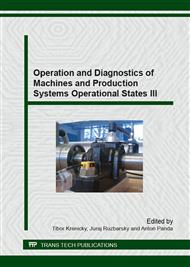[1]
H.A. Youssef, H. El-Hofy, Machining Technology: Machine Tools and Operations, CRC Press, (2008).
DOI: 10.1201/9781420043402
Google Scholar
[2]
A. Panda et al., Accompanying phenomena in the cutting zone machinability during turning of stainless steels, International Journal of Machining and Machinability of Materials 5/4 (2009) 383-400.
DOI: 10.1504/ijmmm.2009.026899
Google Scholar
[3]
B.S.P. Nagendra, R.K. Mittal, Elements of Manufacturing Proces, Prentice-Hall of India Private, (2006).
Google Scholar
[4]
E. Isakov, Cutting Data for turning of steel, Industrial Press, New York, (2009).
Google Scholar
[5]
E.D. Whitney, Ceramic Cutting Tools, William Andrew Publishing/Noyes, (1994).
Google Scholar
[6]
J. Duplák, T-vc dependence for cutting ceramic in standard ISO 3685, Manufacturing Engineering 9/4 (2010) 58-62.
Google Scholar
[7]
J. Duplák, Identification of comprehensive T-vc dependence, Thesis, FMT TUKE, Prešov, (2010).
Google Scholar
[8]
J. Duplák, Verification of T-vc dependence for standard ISO 3685, in: Progressive technologies of machining: Papers of center of progressive technologies 2010, Prešov, FVT TU, pp.45-52.
Google Scholar
[9]
J. Duplák, M. Hatala et. al, T-Vc Dependence for sintered metal in standard ISO 3685, Technological Engineering 7/2 (2010) 6-9.
Google Scholar
[10]
J.T. Black, R.A. Kohser, Degarmo's Materials & Processes In Manufacturing, Wiley India Private, (2007).
Google Scholar
[11]
J.R. Davis, Materials: ASM Specialty Handbook, ASM International, Ohio, (1998).
Google Scholar
[12]
J. Mihok, J. Markovič, Importance of planning as a core function of strategic management, Management of Companies (Manažment podnikov) 3/2 (2013) 57-58.
Google Scholar
[13]
J. Zajac et al, Cutting facilities of new type of came cutting material, in: Proceedings of the Conference PPTO, Košice, 1995, pp.138-139.
Google Scholar
[14]
K. Vasilko, Analytical theory of splinter machining, FMT TUKE, Prešov, (2007).
Google Scholar
[15]
M. Cuma, M. Janak, The impact of cutting fluids on machining, in: Proc. of Int. Conf. ICPM 2009; FMT TUKE, Prešov, 2009, pp.25-30.
Google Scholar
[16]
R. Cep et al., Ceramic cutting tool tests with interrupted cut simulator, in: Proc. of International Conference on Innovative Technologies IN-TECH 2010, Praha, 14-16. 9. 2010, AS, Jaroměř, 2010, pp.144-148.
Google Scholar
[17]
R. Cep et al, Surface roughness after machining and influence of feed rate on process, Key Engineering Materials 581 (2014) 341-347.
Google Scholar
[18]
S. Hloch, J. Valíček, Prediction of distribution relationship of titanium surface topography created by abrasive waterjet, International Journal of Surface Science and Engineering 5/2 (2011) 152–168.
DOI: 10.1504/ijsurfse.2011.041399
Google Scholar
[19]
S. Gašpar, J. Maščenik, J. Paško, The effect of degassing pressure casting molds on the quality of pressure casting, Advanced Materials Research 428 (2012) 43-46.
DOI: 10.4028/www.scientific.net/amr.428.43
Google Scholar
[20]
T. Krenický, Non-contact Study of Surfaces Created Using the AWJ Technology, Manufacturing Technology 15/1 (2015) 61-64.
DOI: 10.21062/ujep/x.2015/a/1213-2489/mt/15/1/61
Google Scholar
[21]
STN ISO 3685: Tool-life testing with single-point turning tools, (1999).
Google Scholar


